24 Purple Flowering Shrubs (with Pictures) – Identification and Planting Guide

Purple flowering shrubs are excellent additions to your landscape to add beautiful colors. Shrubs with purple flowers can add hues of lilac, lavender, plum, violet, and mauve. In full bloom, the colorful purple bushes contrast with luscious green foliage, creating exciting color combinations. By planting perennial flowering bushes, you have flowers that come back year after year. With evergreen flowering shrubs, your garden can have color in your landscape throughout the year.
Growing purple flowering shrubs in your front or backyard can be straightforward. You should select flowering bushes suitable for your growing zone, hours of daily sunshine, and soil type. In addition, it’s always best to choose low-maintenance shrubs to cut down on gardening time. This way, you can enjoy purple flowers and delightful fragrances without spending a long time pruning, fertilizing, and watering the bushy plants.
Even if you don’t have a large yard to plant big flower bushes, many purple landscape plants are relatively compact and grow well in containers. For example, when grown in pots, dwarf purple flowering shrubs can decorate a patio, deck, entranceway, or container garden.
This article is a complete guide to the best purple landscape shrubs, bushes, and plants for your garden landscape. In addition, pictures of the purple flowering bushes will help you find suitable plants to grow around your house.
How to Choose the Best Shrubs with Purple Flowers
Selecting the best flowering shrubs for your garden depends on several factors. The first factor is location. Flowering evergreen and perennial shrubs can grow as hedges, foundation plants, along borders, or at the back of a flower bed. It’s also good to consider the amount of sunlight or shade the plant gets.
One of the most critical factors in ensuring flowering shrubs perform at their best is your temperature zone. Many perennial flowering plants thrive in USDA zones 5 through 9. So, you can grow rhododendrons, lilac, rose of Sharon, wisteria, and butterfly bushes in temperate climates. However, purple shrubs like fuchsias, bougainvillea, and golden dewdrops need warm temperatures to thrive outdoors.
Purple Flowering Shrubs (With Pictures): Identification Guide
Let’s look in detail at beautiful flowering shrubs that will fill your garden with blooms of purple shades from spring through fall.
Purple Hydrangea Shrubs (Hydrangea macrophylla)

Purple flowering hydrangea shrubs add a stunning focal point to the front of garden as a foundation plant
Hydrangeas are large deciduous shrubs with showy flowers, including spectacular purple blooms. Purple hydrangea shrubs can be identified by their large globe-like bluish-purple blooms that are made up of small five-petaled flowers. Depending on the type of hydrangea, the large purple flower heads can measure between 4” and 14” (10 – 35 cm) across.
The various types of flowering hydrangea bushes are bigleaf hydrangeas, smooth hydrangeas, panicle hydrangeas, and oakleaf hydrangeas. Typically, most varieties of purple hydrangea bushes are the bigleaf Hydrangea macrophylla variety. These flowering bushes grow in zones 5 to 9. Under the right conditions, the flowering perennials will bloom all through summer until the end of fall.
- USDA zone: 5 to 9
- Size: 4 to 5 ft. (1.2 m – 1.5 m) tall
- Light Exposure: Full sun to partial shade
- Soil: Organically rich, well-drained soil
Related reading: How to care for hydrangea flowering bushes.
Purple Fuchsia Shrubs

Fuchsia is a low growing shrub with attractive flowers in various shades of red, pink, and purple
Fuchsia is a type of small flowering shrub that is a popular garden plant for its colorful purple, pink, and red flowers. Fuchsia shrubs grow 1 to 2 ft. (0.3 – 0.6 m) tall and produce decorative drooping flowers with a purple tear-shaped center called a corolla surrounded by bright red or pink petals.
Purple flowering fuchsia shrubs are ideal for planting in mixed borders, along walls, or in containers. The attractive arching branches contain numerous pendulous flowers, creating a showy red and purple floral display. You can grow fuchsia shrubs in the ground in USDA zones 8 through 11. However, varieties of hardy flowers are cold hardy to zone 6. Plant your fuchsia shrubs in a shady location or in an area that gets morning sun and afternoon shade.
- USDA zone: 8 to 11
- Size: 1 to 2 ft. (0.3 – 0.6 m) tall
- Light Exposure: Partial sun to shade
- Soil: Fertile, well-drained soil
Purple Flowering Rhododendron Shrubs

You can choose a dwarf purple rhododendron flowering shrub for landscaping a compact garden
Many varieties of rhododendron shrubs bloom with showy purple, purplish-pink, or mauve flowers. The funnel-shaped purple flowers have frilled petals and grow up to 4” (10 cm) wide. When in bloom, the trumpet-like, colorful flowers give off a pleasant fragrance. These hardy flowering bushes thrive in USDA zones 5 through 9; however, there is variation among varieties.
Rhododendrons thrive in full sun or partial shade and easily grow in well-drained soils. If the large rhododendron shrubs are too big for your yard, choose from the compact, purple-flowering dwarf rhododendrons that grow between 3 and 6 ft. (1 – 2 m) tall and wide.
With the proper pruning, rhododendrons are excellent front-of-house plants or colorful foundation plantings.
- USDA zone: 5 to 9
- Size: 3 and 6 ft. (1 – 2 m) tall and wide
- Light Exposure: Full sun to partial shade
- Soil: Well-drained soil
Azalea

Purple flowering azalea shrubs thrive in full sun or partial shade in well-drained soil
Azalea shrubs belong to the rhododendron genus, and many varieties produce stunning purple blooms. Some types of evergreen azaleas have deep purple flowers that last the whole summer. Other deciduous purple azaleas have flowers that come back year after year. Azaleas perform best in full sun to partial shade and grow between 3 and 8 ft. (1 – 2.4 m) depending on the species.
Varieties of purple-flowering azaleas include the Formosa azalea, ‘Autumn Lilac,’ ‘April Rose,’ and Satsuki evergreen azaleas.
You can also grow purple rhododendron and azalea shrubs as a flowering hedge. The evergreen plants have dense growth, making them ideal for privacy screens, living fences, and security hedges. From late spring throughout the summer, the leafy green foliage seems to come alive with lilac, purple, and violet shades.
- USDA zone: 5 to 9
- Size: 3 and 8 ft. (1 – 2.4 m) tall
- Light Exposure: Full sun to partial shade
- Soil: Well-drained soil
Related reading: How to care for azalea shrubs.
Bluebeard (Caryopteris x clandonensis)
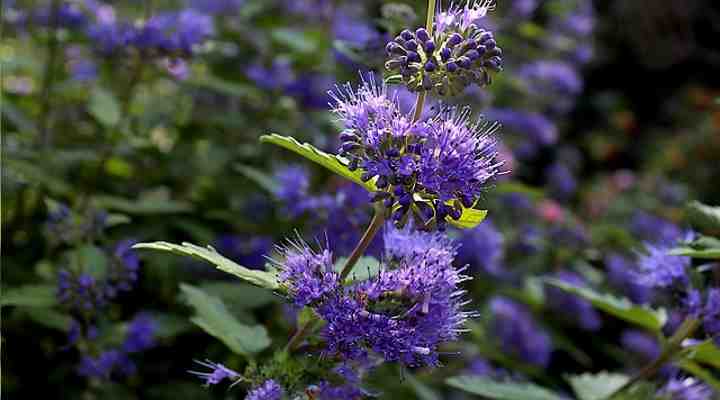
The small bluebeard shrub has purple flowers that add a decorative touch to a front of backyard
Bluebeard is a small deciduous shrub with small purple flowers on upright stems and silvery-green foliage. This compact, clump-forming shrub grows 2 to 3 ft. (0.6 – 1 m) tall. The purple blooms appear in late summer and early fall and fill the garden air with pleasant scents.
Bluebeard shrubs grow best in USDA zones 6 through 9. It is best to plant the sun-loving shrub in well-drained soil. Because the purple shrub is relatively tolerant of drought, it’s an excellent low-maintenance plant for front gardens, perennial borders, butterfly gardens, or containers.
- USDA zone: 6 to 9
- Size: 2 to 3 ft. (0.6 – 1 m) tall
- Light Exposure: Full sun
- Soil: Well-drained soil
Butterfly Bush (Buddleja)
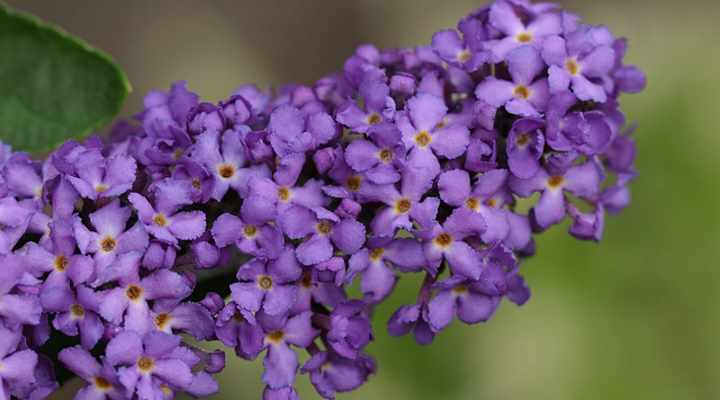
Butterfly bush has beautiful flowers that are typically purple, pink, and white, but can come in yellow and orange colors too
The butterfly bush is identified by its stunning cone-shaped clusters of purple flowers. The purple perennial shrubs bloom in mid-summer, and the purple flowers persist until frost. Masses of spectacular lilac-colored flowers cover the rounded shrub, attracting butterflies and producing sweet scents. The bushy butterfly shrubs grow between 5 and 10 ft. (1.5 – 3 m) tall.
For a compact garden, choose from a dwarf variety of butterfly bushes. The beautiful flowering shrubs have showy, conical purple flowers. All types of butterfly bush are ideal for foundation planting, container growing, cottage gardens, or perennial borders.
- USDA zone: 5 to 10
- Size: 5 and 10 ft. (1.5 – 3 m) tall
- Light Exposure: Full sun
- Soil: Well-drained soil
Lavender (Lavandula spp.)

Extremely popular worldwide, purple lavender shrubs are especially beautiful when planted en masse
Lavender is a small herbaceous plant or small shrub that produces spikes of fragrant purple flowers. These tall flowering clusters can range in shades from violet and lilac to light blue or dark purple. Also called common lavender, this woody shrub-like perennial grows in clumps and typically grows 2 to 3 ft. (0.6 – 1 m) tall.
Purple lavender shrubs thrive in USDA zones 5 through 9. They are low-maintenance perennial flowering shrubs that grow in full sun and well-drained soil. Although lavender plants with purple flowers are the most common varieties, there are also types with white-flowering lavender (Lavandula angustifolia ‘Nana Alba’) and lavender with pink flowers (Lavandula angustifolia ‘Rosea’).
- USDA zone: 5 to 9
- Size: 2 to 3 ft. (0.6 – 1 m) tall
- Light Exposure: Full sun
- Soil: Well-drained soil
Lilac Shrubs (Syringa vulgaris)

Lilac bushes produce attractive cone-like flowers in shades of purple, pink, or white
Lilac is a large, rounded flowering shrub producing clusters of purple, violet, lavender, rose, magenta, and lilac-colored flowers. The large cone-like flower clusters (panicles) grow up to 8” (20 cm) long and produce a strong fragrance. Lilac flowers bloom for up to four weeks in late spring.
Flowering lilac shrubs typically grow 8 to 15 ft. (2.4 – 4.5 m) tall and wide. However, for smaller yards, you can plant dwarf lilacs that don’t grow taller than 4 ft. (1.2 m). A benefit of growing lilac shrubs is that they are cold-hardy in zone 3 and thrive in most soil types.
You can grow lilac shrubs as deciduous hedgerows, specimen plants, or screens for privacy in the summer.
- USDA zone: 3 to 7
- Size: 8 to 15 ft. (2.4 – 4.5 m) tall and wide
- Light Exposure: Full sun
- Soil: Fertile, humus-rich, well-drained soil
Related reading: Lilac Bush: Facts, Flowers and Growing Guide.
Clematis

To increase flower production, it’s best to plant your purple clematis shrub in full sun
Clematis is a group of flowering vines, but some can be grown like shrubs with purple flowers. Herbaceous clematis is a type of clump-forming perennial with flowers and leaves like the climbing varieties. The bell-shaped drooping flowers have four or five curved purple or blue petals that appear in summer and fall.
Non-climbing clematis shrubs are typically low-growing and reach between 1 and 8 ft. (0.6 and 2.5 m) tall and up to 3 ft. (1 m) wide. The woody shrubs die back in late fall and remerge in spring to bloom again in early summer. Planting clematis in full sun ensures plenty of beautiful blooms.
- USDA zone: 4 to 9
- Size: 1 and 8 ft. (0.6 and 2.5 m) tall, 3 ft. (1 m) wide
- Light Exposure: Full sun
- Soil: Fertile, moist, well-drained soil
Purple Flowering Jane Magnolia (Magnolia liliiflora x Magnolia stellata)

Jane magnolia is a purple flowering plant that can grow as a large shrub or as a small tree.
The Jane magnolia is a slow-growing purple flowering shrub or a small tree that produces showy, cup-shaped fragrant flowers.
Jane magnolia shrub has fragrant purple-pink large tulip flowers that grow up to 8” (20 cm) across. The landscaping shrub’s foliage is made up of 6-inch (15-cm) long, ovate, shiny green leaves.
The compact Jane magnolia bush grows between 10 and 15 ft. (3 – 4.5 m) tall. The purple flowering Jane magnolia grows best in USDA zones 4 – 8 in full sun to part shade.
The Jane magnolia is part of a series of hybrids of the Magnolia liliiflora and Magnolia stellata called “The Little Girl Series.” Some of the other magnolias in the series are ‘Susan’ magnolia with purplish-red blooms and the ‘Ann’ magnolia with deep-purple, pink flowers.
- USDA zone: 4 to 8
- Size: 10 and 15 ft. (3 – 4.5 m) tall
- Light Exposure: Full sun to partial shade
- Soil: Moist, well-drained soil
Golden Dewdrops (Duranta erecta)
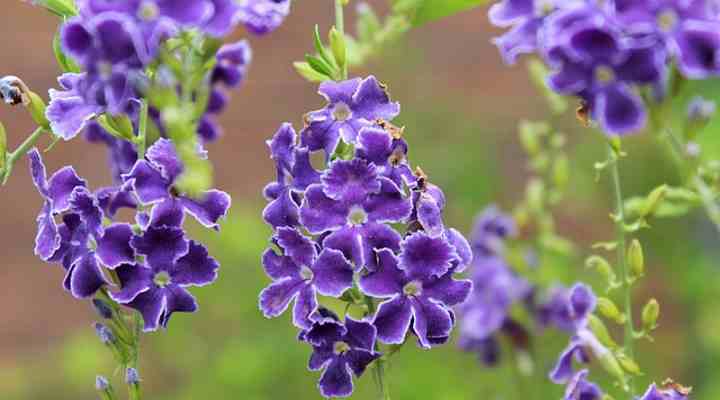
The golden dewdrops shrub with its beautiful purple flowers thrive in warm weather and full sun
The golden dewdrops is a heat-loving evergreen shrub with vibrantly colored clusters of purple and white flowers. The star-shaped purple flowers consist of five purple petals with white margins. The loose dangling panicles on arching stems grow up to 6” (15 cm) long and emit a sweet vanilla-like fragrance.
In subtropical climates, the golden dewdrops grows as an evergreen ornamental shrub. However, it is only cold-hardy in zones 10 and 11. Therefore, in temperate climates, you must grow this show-stopping shrub in a container and overwinter it indoors or grow it as an annual.
As a word of warning: after the purple flowers fade, brightly colored orange berries appear. While birds enjoy consuming them, the berries are highly poisonous to humans and animals.
- USDA zone: 10 and 11
- Size: 10 to 20 ft. (3 – 6 m) tall
- Light Exposure: Full sun
- Soil: Moist, well-drained, fertile soil
Evergreen Purple Flowering Bougainvillea Shrub

Bougainvillea is a flowering climbing shrub that comes in various colors and thrives in full sun
Bougainvillea is an evergreen thorny vining plant or spreading shrub that produces masses of purple, magenta, or pink flower-like bracts throughout the summer. The flowers on a bougainvillea shrub are actually tiny white blooms. The intense color of the plant is from the showy bracts surrounding the flowers.
Flowering evergreen bougainvillea shrubs are common in southern states. In addition, the showy, colorful bushes adorn gardens in Florida, California, South Carolina, and countries around the Mediterranean.
Bougainvillea is a scrambling shrub that grows between 3 and 40 ft. (1 to 12 m) tall. The papery red, white, pink, or purple-like flowers appear throughout the summer when grown in zones 9 and 10.
- USDA zone: 9 and 10
- Size: 3 and 40 ft. (1 to 12 m) tall
- Light Exposure: Full sun
- Soil: Well-drained soil
Purple Crape Myrtle Bushes (Lagerstroemia indica)
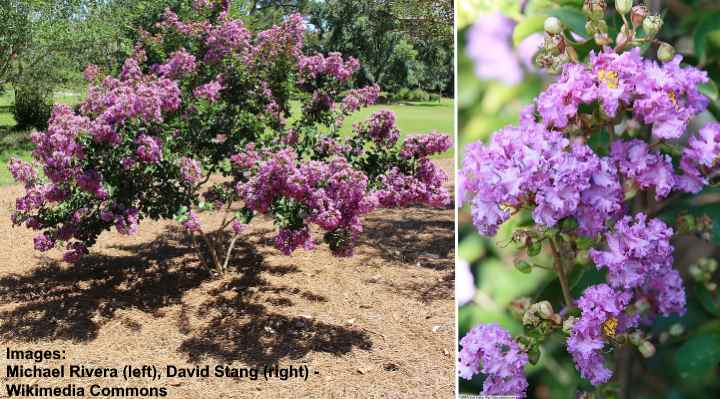
The catawba crape myrtle shrub starts blooming in late summer, and the purple and lavender flower clusters last until the fall
Crape myrtle is a beautiful shrub with large purple flowers, a broad, spreading crown, and attractive leaves. Other identifiable features of the crape myrtle shrub are cinnamon-colored bark and bright orange-red fall foliage. The purple flower clusters appear in late summer and persist until the fall.
There are several varieties of crape myrtle shrubs. Some dwarf shrubs grow 2 to 4 ft. (0.6 – 1.2 m) tall, whereas larger shrubs grow between 5 and 15 ft. (1.5 – 4.5 m) tall and up to 10 ft. (3 m) wide.
Varieties of crape myrtle shrubs with purple flowers include Catawba Crape Myrtle (Lagerstroemia indica ‘Catawba’), ‘Early Bird Purple,’ ‘Early Bird Lavender,’ and ‘Purple Magic.’
- USDA zone: 6 to 10
- Size: 5 to 15 ft. (1.5 – 4.5 m) tall, 10 ft. (3 m) wide
- Light Exposure: Full sun
- Soil: Slightly acidic, well-drained soil
Related reading: How to care for crape myrtle bushes.
Rose of Sharon (Hibiscus syriacus)
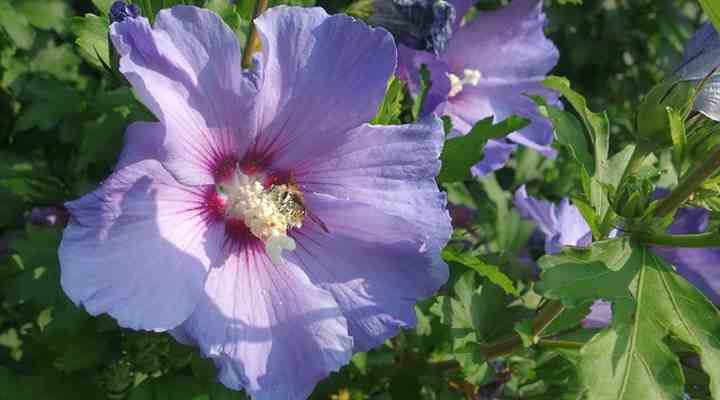
Rose of Sharon (Hibiscus syriacus) is a type of cold hardy hibiscus shrub with ornamental flowers in shades of purple, pink,fv and white
Rose of Sharon is a type of hardy hibiscus shrub with showy trumpet-shaped pale purple flowers and a deep purple throat. The five-petaled flowers have ruffled petals, a large protruding stamen, and a sweet fragrance. A colorful rose of Sharon shrub can grow 8 to 12 ft. (2.4 – 3.6 m) high and up to 10 ft. (3 m) wide.
A rose of Sharon shrub thrives in USDA zones 5 through 8 in full sun to partial shade. Plenty of sunshine encourages the deciduous perennial to produce masses of colorful flowers. Depending on the species, the light purple or pink flowers can be single or double and bloom for a long time.
Plant a rose of Sharon shrubs as a foundation planting, summer hedge, or shrub border. With the proper pruning and training, you can also grow a spectacular hibiscus tree.
- USDA zone: 5 to 8
- Size: 8 to 12 ft. (2.4 – 3.6 m) tall, 10 ft. (3 m) wide
- Light Exposure: Full sun to partial shade
- Soil: Organically rich, well-drained soil
Related reading: How to care for hibiscus shrubs.
Wisteria

The stunning purple flowers of the wisteria climbing shrub dangle beautifully over arbors or pergolas
Wisteria is a flowering vine that can grow as a spectacular shrub. The fragrant flowering plant produces masses of white, pink, and purple blossoms on drooping clusters. The eye-catching ornamental flowers on a wisteria plant can be 12” to 18” (30 – 45 cm) long. As a blooming vine, wisteria grows 10 to 25 ft. (3 – 7.6 m) tall.
To enjoy purple wisteria flowers, you can also grow the woody vining plant as a small shrub-like tree. You should prune suckers that appear and stake the central stem for support. In time, you will have a small flowering shrub around 6 ft. (1.8 m) tall and up to 10 ft. (3 m) wide.
Alternatively, you can also grow wisteria as a container shrub to enjoy the lavender or purple flower clusters.
- USDA zone: 5 to 9
- Size: 6 ft. (1.8 m) tall, 10 ft. (3 m) wide.
- Light Exposure: Full sun
- Soil: Moist, well-drained soil
Purple Rose Shrub

There are beautiful varieties of rose hybrids and cultivars to suit any garden
There are several varieties of purple-flowering rose shrubs that can add dramatic color to your summer garden. Shrub roses are some of the most spectacular flowers for your landscape. Rose shrubs can grow between 4 and 6 ft. (1.2 – 1.8 m) tall and produce masses of showy blooms in deep plum-purple, pale lilac, and pinkish-purple.
Most varieties of purple shrub roses have an informal, bush-like growth. The purple flowers can be open flowers with five petals, or they can have multiple frilly petals forming a double flower.
- USDA zone: 2 to 7
- Size: 4 to 6 ft. (1.2 – 1.8 m) tall
- Light Exposure: Full sun
- Soil: Moist, humus-rich, well-drained soil
Winter Heath (Erica x darleyensis)
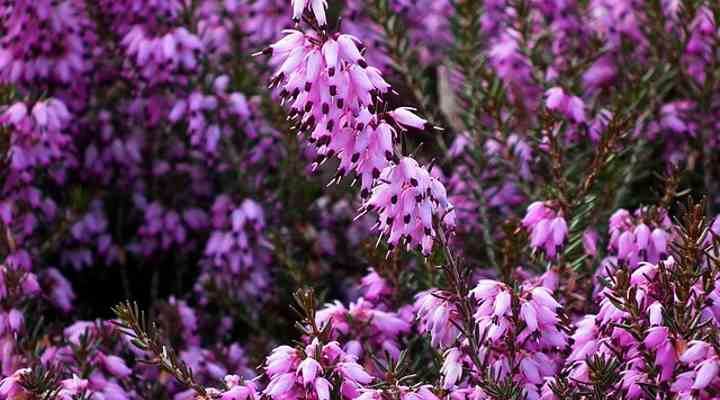
The ornamental small winter heath shrub is grown for its evergreen foliage and purple flowers
Winter heath is a low-growing woody shrub that produces clusters of urn-shaped pinkish-purple or pink-lilac flowers. The bushy heath shrubs grow around 18” (45 cm) tall and can be identified by their thin needle-like evergreen leaves growing on erect stems. The tiny light purple or dark pink bell flowers grow along the length of the stem, contrasting with the dark green leaves.
Winter heath is a winter-flowering ornamental plant that blooms in late winter to early spring. The spectacular evergreen foliage and pale purple or pink flowers contrast with the snow and provide color to a barren landscape.
- USDA zone: 6 to 9
- Size: 1.5 ft. (0.4 m) tall
- Light Exposure: Full sun
- Soil: Well-drained soil
Heather (Calluna vulgaris)

Heather is a low growing purple flowering shrub that can be grown in both full sun and part shade
Heather is an evergreen shrub that produces clusters of tiny flowers in shades of purple, mauve, pink, and red. The ornamental flowers grow as racemes on the ends of upright woody stems. Unlike the related winter heath, heather typically blooms in late summer and fall. Heather grows 8” to 20” (20 – 50 cm) tall.
The cold-hardy wild shrub can turn landscapes into spectacular shades of purple when in bloom. In addition, some ornamental varieties of heather have attractive red or gold foliage that becomes more intense in cold weather.
Grow heather in containers or along borders for year-long evergreen foliage and light purple summer and fall flowers.
- USDA zone: 4 to 7
- Size: 0.6 to 1.6 ft. (0.2 – 0.5 m) tall
- Light Exposure: Full sun to partial shade
- Soil: Acidic, well-drained soil
Russian Sage (Salvia yangii)
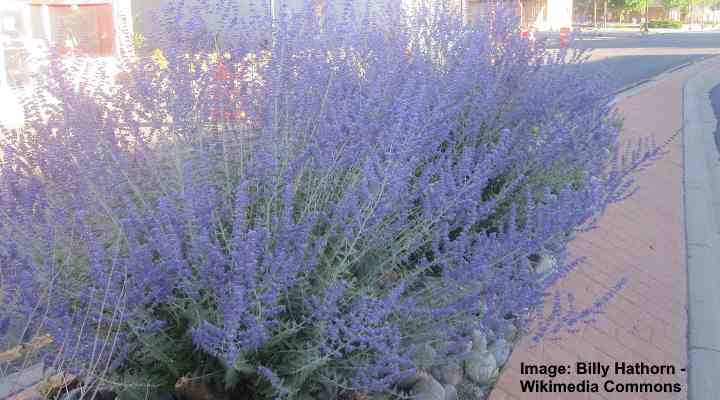
Russian sage is one of the best purple flowering, hardy, and drought tolerant plants to landscape your garden
Russian sage is a small herbaceous shrub with upward growing thin stems covered on lavender-blue flowers. The blue to violet blossoms appear from mid-summer until late fall. The spray of airy stems creates a hazy, pale purple effect in summer landscapes.
Additionally, the aromatic leaves have a sage-like aroma when crushed. Russian sage grows 1.6 to 4 ft. (0.5 – 1.2 m) tall.
Russian sage is ideal for growing as a deciduous perennial in shrub borders, along driveways, and in containers. In addition, the purple lavender flowers persist on the shrub despite drought, making the flowering shrub ideal for xeriscaping.
- USDA zone: 3 to 9
- Size: 1.6 to 4 ft. (0.5 – 1.2 m) tall
- Light Exposure: Full sun
- Soil: Well-drained soil
Chaste Tree (Vitex agnus-castus)

The chaste tree is a small, deciduous shrub native to the Mediterranean. The shrub is recognized for its attractive, upright clusters of fragrant purple blossoms. During early summer, the tree’s spreading canopy, resembling a vase, becomes adorned with spiky lilac flower clusters, adding beauty to the landscape. Other identifying features include black, peppercorn-like fruits and dark green, palmately compound leaves with silvery undersides.
The chaste tree is also known by other names such as monk’s pepper or lilac chaste tree. With its abundant leaves and attractive flowers, this shrub is sure to enhance the appeal of any outdoor landscape.
Landscaping ideas for chaste trees include planting in shrub borders, foundation plantings, or as individual focal points. They are resilient to most pests and diseases. During the summer months, the delightful fragrance of its purple blossoms lures butterflies, bees, and various other pollinators.
- USDA zone: 6 to 9
- Size: 4 to 15 ft. (1.2 – 4.5 m) tall and wide
- Light Exposure: Full sun
- Soil: Well-drained soil
Clematis ‘Betty Corning’
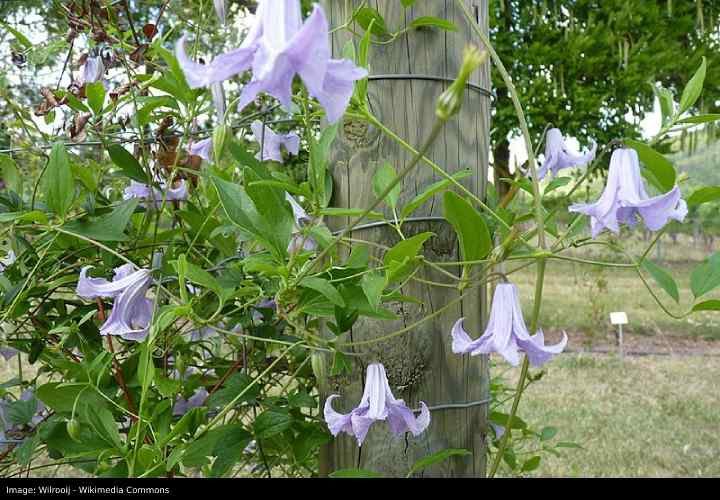
The Clematis ‘Betty Corning’ is a medium-sized, deciduous shrub known for its sweet-smelling, trumpet-shaped flowers that are a purple-lavender hue. The flowers bloom from midsummer until fall. The shrub features pinnate, heart-shaped, dark green leaves that contrast beautifully with the purple flowers.
The Clematis ‘Betty Corning’ can be trained to climb a wall, trellis, or archway. Its attractive flowers and lush foliage are sure to add a touch of beauty to any landscape.
- USDA zone: 4 to 9
- Size: 6 ft. (1.8 m) tall
- Light Exposure: Full sun to partial shade
- Soil: Moist, well-drained soil
Hebe x franciscana ‘Blue Gem’
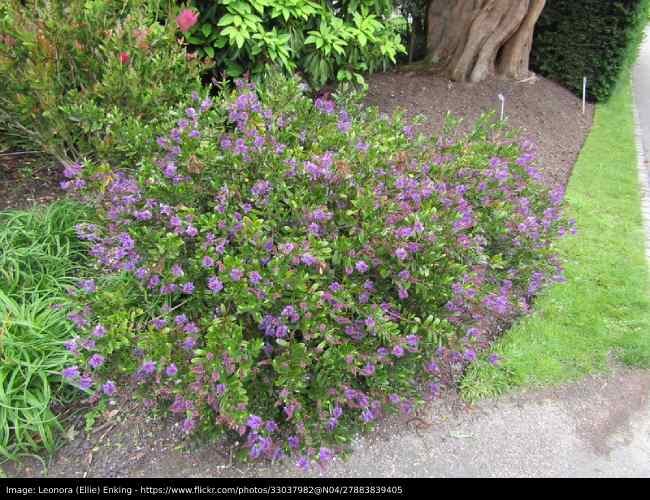
Hebe x franciscana ‘Blue Gem’ is a spreading, evergreen shrub with a bushy growth habit. The shrub is known for its tightly-packed purple flowers that bloom from summer until autumn. It features elliptic to lance-shaped, glossy mid-green leaves. The plant is drought-tolerant and capable of withstanding temperatures down to -10°C (14°F). It can also be grown in coastal areas. This shrub is best grown as a specimen or foundation plant.
- USDA zone: 8 to 11
- Size: 4.9 ft. (1.5 m)
- Light Exposure: Full sun to partial shade
- Soil: Well-drained soil
Rosa ‘Poseidon’

Rosa ‘Poseidon’ is a bushy, upright shrub with attractive, pale-purple flowers with up to 60 petals. The shrub has light green, glossy leaves with jagged edges and a bushy, spreading growth habit. Its compact size makes it great for planting in small gardens as a decorative shrub. Other landscaping ideas include planting in a mixed border or in the front of house.
- USDA zone: 5 to 10
- Size: 3 to 4 ft. (0.9 – 1.2 m) tall
- Light Exposure: Full sun
- Soil: Well-drained soil
Heliotrope (Heliotropium arborescens)
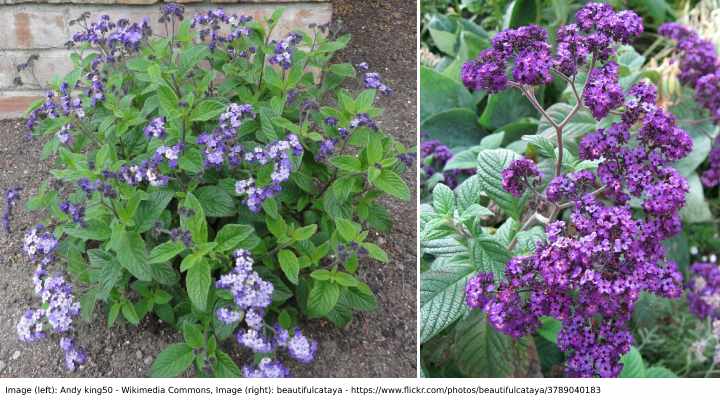
The heliotrope is a tender, evergreen shrub known for its beautiful, small, showy purple flowers. The flowers grow in domed clusters and have a fragrant, vanilla-like scent. This shrub blooms from summer until fall. It also features wrinkled, oval-shaped, dark green leaves. This shrub is most often grown as a container plant. It is important to note that the plant requires wintering indoors in zones 9 and below.
- USDA zone: 9 to 11
- Size: 2 to 6 ft. (0.6 to 1.8 m) tall, 6 to 8 ft. (1.8 to 2.4 m) wide
- Light Exposure: Full sun
- Soil: Organically rich, moist, well-drained soil
Related articles:
- Ground Cover Plants with Purple Flowers
- Purple Perennial Flowers for Your Garden
- Small or Dwarf Flowering Shrubs
